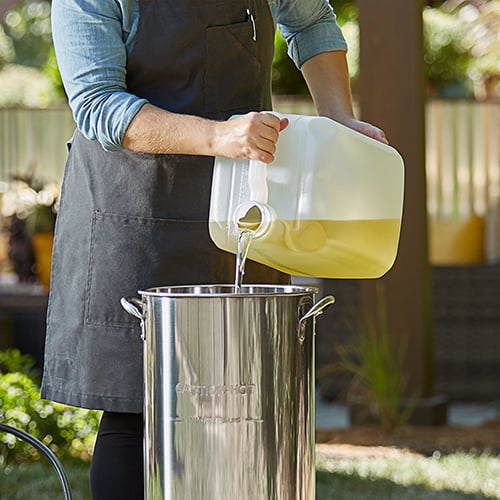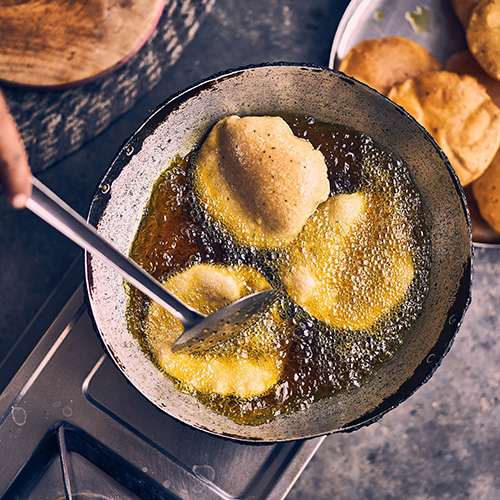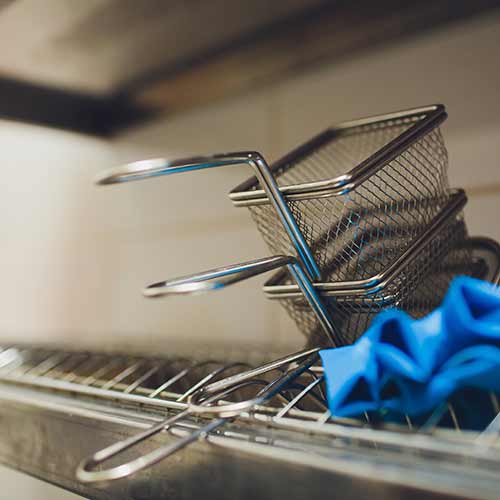How To Filter Cooking Oil
You can find fried foods on the menus from all kinds of establishments. Whether you own a burger place, an Italian restaurant, or you want to try frying a turkey as a holiday special, knowing what oil to use in your fryer and how to maintain it is key for producing high-quality fried foods. In this article, we will tell you how to select the best deep fryer oil, how often you should change it, how to filter fryer oil, and even how to dispose of your oil once it becomes unusable.
Shop All Fryer Oil Filtration Accessories
Best Oil for Frying
Vegetable oil is the best oil for deep frying. Canola oil and peanut oil are other popular options.

While vegetable oil, canola oil, and peanut oil are the most popular oils for deep frying, there are several other oil options you can choose:
- Grapeseed Oil
- Soybean Oil
- Lard
- Corn Oil
- Cottonseed Oil
Healthiest Oil for Frying
The healthiest oil to fry with is olive oil. Another great option is avocado oil. These oils are high in monosaturated fats, which is considered to be a healthy fat in comparison to polyunsaturated fats.
Best Oil to Fry Chicken
Vegetable oil, canola oil, and peanut oil are the best oils to fry chicken. Their high smoke points and neutral tastes make them ideal for frying chicken.
Best Oil for French Fries
The best oil to fry french fries is a neutral-tasting oil, such as vegetable, canola, or peanut oil. These oils also have a high smoke point, which is ideal for making sure your oil doesn't burn too quickly.
Peanut Oil for Frying
Peanut oil is low in saturated fat and high in polyunsaturated and monounsaturated fats. As a result, it is a healthier alternative to other frying fats like shortening and lard. Although it is made from peanuts, not all peanut oil is considered an allergen. Highly refined peanut oil is safe for many people with peanut allergies, while cold-pressed, expelled, and extruded peanut oils are considered allergens.
Vegetable Oil for Frying
Vegetable oil is an ideal oil for frying because it is a great all-purpose oil and can be used for deep-frying, pan-frying, or sauteeing. Vegetable oils are not all the same as some are made up of 100% soybean, while other vegetable oil blends are made of a mix of soybean, sunflower, corn, and more. Since vegetable oils contain different blends, each vegetable oil will have a different smoke point and can range from 400-450 degrees Fahrenheit.
Canola Oil for Frying
Canola oil is a lower-fat alternative to shortening and lard, and it is more affordable than many other cooking oils. Plus, it is easily accessible, making it a popular selection for kitchens everywhere.
Best Oil for Pan Frying
Olive oil is the best oil to use for pan-frying. Coconut oil, avocado oil, sesame oil, and butter are also great oils for pan-frying.
How to Choose the Best Oil for Deep Frying
If you're unsure of what kind of oil to use in your deep fryer, there are two main factors to consider: smoke point and taste.

Oil's smoke point is the temperature at which the oil starts to break down while it is heated. At this temperature, the oil will start to smoke before it eventually catches fire with increased temperature. When oil begins to smoke, it starts to taste "off" and loses much of its nutritional value.
How Can Oil's Taste Affect Food in a Deep Fryer?
Because deep frying requires your food to be submerged in oil for its entire cooking process, using oil with a strong taste can impact the flavor of the food you're frying. For example, olive oil is often recognized for its distinctive taste that is desirable in dishes like pasta or as a dressing for salads. However, its robust flavor may not pair well with many traditional fried foods.
Why Vegetable Oil, Peanut Oil, and Canola Oil Are the Best for Deep Frying
Vegetable oil, peanut oil, and canola oil are ideal for use in deep fryers because of their high smoke points. With vegetable oil's smoke point ranging from 400-450 degrees Fahrenheit, peanut oil's smoke point at 450 degrees Fahrenheit and canola oil's at 400 degrees Fahrenheit, these three oils can remain stable throughout your frying process. Most frying occurs between the temperatures of 350 to 400 degrees Fahrenheit, so it's imperative that you use oil with a smoke point of at least 400 degrees to avoid contaminating the taste of your food and putting yourself at risk of injury.
Vegetable, peanut, and canola oil's neutral taste also make it an excellent candidate for deep frying.
How Often Should I Change the Oil in My Deep Fryer?
How long you can keep oil in your deep fryer depends on what you've been frying and how often, the quality of the oil, and how clean your fryer is. While there is no one-time limit that applies to all situations, it is simple to know when to change your deep fryer oil.
How Do I Know When to Change My Deep Fryer Oil?

Change the oil in your deep fryer when:
- It smokes at lower temperatures than usual
- Darkens in color
- Begins to smell off-putting
- Becomes thickened and foamy at the surface
These are all signs that your oil is breaking down and is no longer usable. This being said, do not wait for all of these signs to change your oil. Any one of these changes can make your oil difficult or unsafe to work with, so it is best to keep your oil fresh.
Can I Leave Oil in My Deep Fryer?
While it is best to store oil outside of your fryer when it is not in use for long periods of time, you can leave oil in your deep fryer for short periods. That being said, it is important to first filter the oil to ensure that any food debris does not spoil while in the fryer. Additionally, you should always keep your fryer covered and cool when it is not in use because light and heat are two of the major factors in oil spoiling.
Ideally, you should store your oil in a cool, dark place. Storing filtered oil in an airtight container that does not let in light can help extend the life of your oil and save you money.
How to Clean and Filter Deep Fryer Oil

Before you can clean and filter your deep fryer oil, you must make sure that the oil is cool. Hot or warm oil could put you at risk for burns and could damage your filtering equipment. Once your oil is cool, use a skimmer to remove any floating food debris from the oil's surface.
How to Filter a Small Batch of Deep Fryer Oil
- Drape cheesecloth over a chinois. This will help to remove small bits of food debris.
- Position your chinois over a funnel and storage container. Make sure that the container is large enough to catch all of the filtered oil.
- Pour the oil slowly through the cheesecloth and chinois. Now your oil is clean and ready for re-use.
How to Filter a Large Batch of Deep Fryer Oil
If you have a larger batch of oil to filter, you may want to consider investing in a fryer oil filtration system. In many cases, these machines will remove the oil from your fryer, filter it, and then return the oil to the fryer. Manual fryer oil filtration machines save energy because they are powered by hand. Electric fryer oil filtration systems power the transfer and filtration process with electricity and are more efficient.
How to Dispose of Deep Fryer Oil
To properly dispose of used cooking oil from your deep fryer, pour your oil into a sealable bag and put it in the trash. Always check your bags for rips or punctures before transferring the oil, because even a slow leak could create a mess in your trash bin or dumpster.
Alternatively, you can find disposal centers that recycle the cooking oil. Some areas have organizations that collect oil for recycling, and they may even pay you for your contributions. If this is not available in your area, you can look into oil collection services for restaurants. These organizations will come to your business and take away your oil for you.
Can You Pour Oil Down the Drain?
No. While it may be tempting to dump your cooking oil down the drain, disposing of your oil this way could be against your local ordinances. Never pour deep fryer oil down your drain, even with hot water. The fat particles in your oil may solidify and block your pipes, causing major problems with your plumbing system.
While deep fryers are great for cooking an array of popular concession stand foods, choosing the right oil and knowing how to maintain it can be tricky. If you have fryers in your commercial kitchen, you know the importance of keeping the oil fresh and clean, so your food can come out as well as possible. When your oil changes color, odor, or becomes foamy, be sure to filter it. If filtering no longer returns your oil to usable condition, put it in a sealed bag in the trash. Now that you know how to select, filter, and dispose of your deep fryer oil, you can confidently serve high-quality fried foods.
How To Filter Cooking Oil
Source: https://www.webstaurantstore.com/article/268/deep-fryer-oil-maintenance.html
Posted by: tierneycanothed.blogspot.com

0 Response to "How To Filter Cooking Oil"
Post a Comment